Wednesday, January 5, 2011
How Often Should I Get A Brazillian Wax
Saturday, January 1, 2011
Prestige Valve Cooker
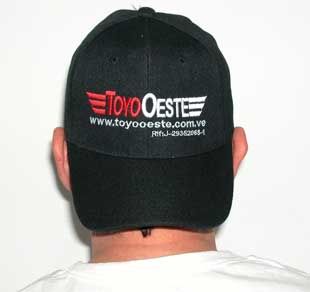 I was always struck by the people who wear baseball caps backwards. It is clear that the visor of caps is designed to protect the eyes from the glare of the sun, so use them upside down, would only make sense in those conditions and occasions when we have a specific need to protect the neck of the radiation of the sun.
I was always struck by the people who wear baseball caps backwards. It is clear that the visor of caps is designed to protect the eyes from the glare of the sun, so use them upside down, would only make sense in those conditions and occasions when we have a specific need to protect the neck of the radiation of the sun. Similarly, it is striking to see a vehicle whose owner has decided to direct the air intake snorkel back.
Does this practice adversely affects the efficiency of the engine intake system?
Taking into account the aerodynamic behavior of the snorkel, and the effect of this on the engine air intake can not be ignored, we decided to conduct a little experiment to try to quantify the difference between making use of snorkel facing forward or backward.
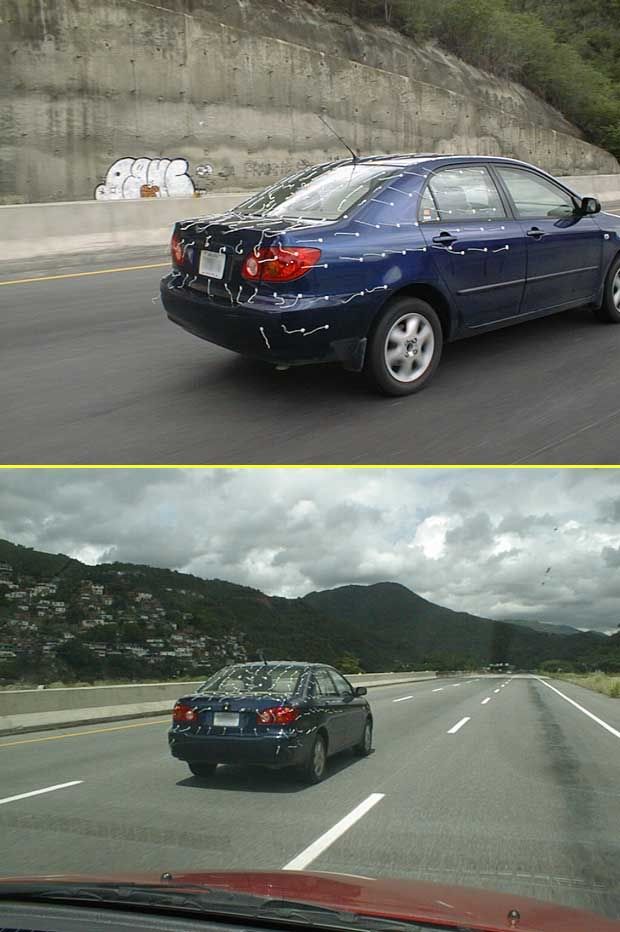 In these images, taken by some in the Caracas-Guarenas few years ago, one can see easily the difference between the air flow laminar and turbulent flow. Notice how the pieces of wire in the central area of \u200b\u200bthe rear window and top of the bag are oriented haphazardly, suggesting the separation of air flow and turbulence in these areas.
In these images, taken by some in the Caracas-Guarenas few years ago, one can see easily the difference between the air flow laminar and turbulent flow. Notice how the pieces of wire in the central area of \u200b\u200bthe rear window and top of the bag are oriented haphazardly, suggesting the separation of air flow and turbulence in these areas.
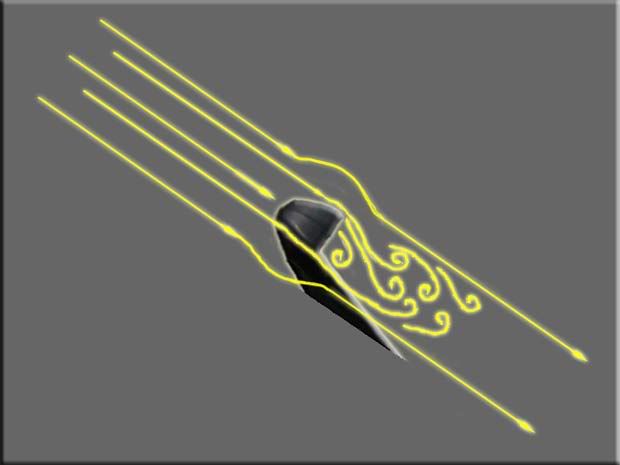 Similar to the previous example, in the case of a snorkel, we should consider the turbulence that it leaves in its wake. The purpose of this Admission is trying to determine quantitatively the inconvenience of making the engine breathe air from an area of \u200b\u200bturbulent flow, such as when you orient the air intake snorkel back. It is easy to see that any difference in engine air intake is of greater magnitude in so far as to increase the speed of the test vehicle and engine rpm, as it will be higher also the degree of turbulence in the wake and the air flow required by the engine to operate.
Similar to the previous example, in the case of a snorkel, we should consider the turbulence that it leaves in its wake. The purpose of this Admission is trying to determine quantitatively the inconvenience of making the engine breathe air from an area of \u200b\u200bturbulent flow, such as when you orient the air intake snorkel back. It is easy to see that any difference in engine air intake is of greater magnitude in so far as to increase the speed of the test vehicle and engine rpm, as it will be higher also the degree of turbulence in the wake and the air flow required by the engine to operate.
In an internal combustion engine, the restrictions that hinder the entry of the intake air to the cylinders, manifest as falls Pressure (also known as vacuum) generated as a result of the downward movement of the pistons (normally aspirated engines). So the determination of the difference in pressure drop of the intake system of our Land Cruiser test before and after turning the air intake snorkel, will reveal the truth about this issue.
 As we expected that differences in pressure drop were very small, we make the measuring instrument can detect much smaller quantities than those who could show the pressure gauges vacuum normally available in the homes of auto accessories and auto parts. In our homemade instrument, the scale ranges from 0 to 100 cm of water. As a reference, it is good to remember that a cm. H ₂ O is equivalent to 0.0142 pounds per square inch or PSI. The hose connection is made before the throttle.
As we expected that differences in pressure drop were very small, we make the measuring instrument can detect much smaller quantities than those who could show the pressure gauges vacuum normally available in the homes of auto accessories and auto parts. In our homemade instrument, the scale ranges from 0 to 100 cm of water. As a reference, it is good to remember that a cm. H ₂ O is equivalent to 0.0142 pounds per square inch or PSI. The hose connection is made before the throttle.
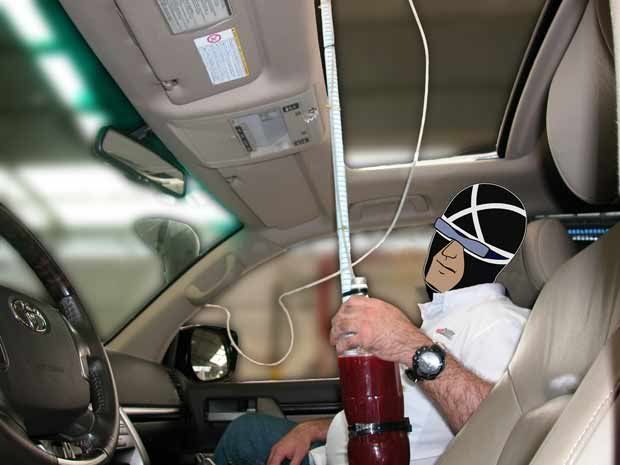 As usual, enlist the help of our friend masked to be in charge of taking such a sophisticated instrument readings while the vehicle was in motion.
As usual, enlist the help of our friend masked to be in charge of taking such a sophisticated instrument readings while the vehicle was in motion.
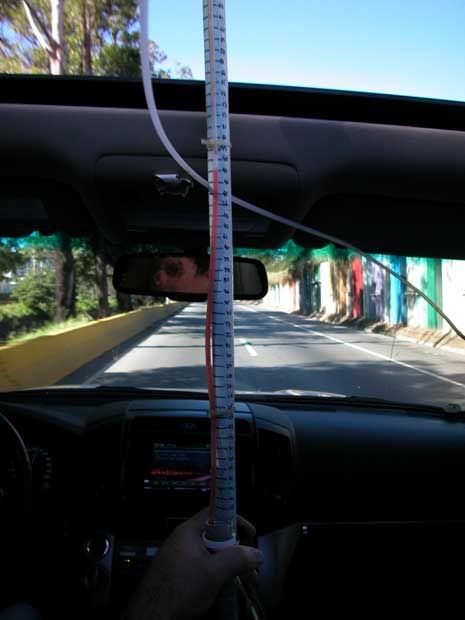 In making measurements on the highway to Caricuao.
In making measurements on the highway to Caricuao.
 In this photo you can appreciate the pressure drop readings, fully loaded, the engine intake system on our test Land Cruiser, while traveling in third gear at 145 km / h and 5,500 rpm. Reading the left corresponds to the air intake facing forward, and the right corresponds to the air intake facing backwards.
In this photo you can appreciate the pressure drop readings, fully loaded, the engine intake system on our test Land Cruiser, while traveling in third gear at 145 km / h and 5,500 rpm. Reading the left corresponds to the air intake facing forward, and the right corresponds to the air intake facing backwards.
RESULTS AND CONCLUSIONS
 This table summarizes the results of this test. For each condition three passes were made in order to rule out errors and guarantee the repeatability required in this type of test.
This table summarizes the results of this test. For each condition three passes were made in order to rule out errors and guarantee the repeatability required in this type of test.
We see in the table, the resistance to airflow intake was to increase by just over 55% as we moved to 145 mph and 5,500 rpm, when rear-facing air intake snorkeling.
In conclusion and in exceptional circumstances can justify the cap put on backwards, we could do the same with the installation of collection of the snorkel back only in very specific situations, like when we rolled through areas or dense jungle vegetation and wish to avoid this becoming entangled in branches or vines.
In all other circumstances, especially if we are traveling at high speed roads and motorways, has been clearly demonstrated that direct the air intake snorkel back is counterproductive to the efficiency of the engine, which will turn manifest as loss of power and increased fuel consumption.
INTAKE SNORKEL ORIENTATION
 I Have Always So Many Wonderer why people wear baseball caps backwards. It Seems pretty clear to me that these caps are meant to protect the eyes from sunlight. Therefore, using them backwards only seems to make sense when we need to protect the back of our necks from the sun.
I Have Always So Many Wonderer why people wear baseball caps backwards. It Seems pretty clear to me that these caps are meant to protect the eyes from sunlight. Therefore, using them backwards only seems to make sense when we need to protect the back of our necks from the sun. Exactly the same thing goes through my mind when I see a snorkel intake installed backwards.
Doesn’t this practice negatively affect the engine’s intake system efficiency?
Considering that the snorkel’s aerodynamic behavior and its possible effect on the engine’s air intake efficiency cannot be ignored, we decided to carry out a small experiment to try to quantify the difference between installing the snorkel facing forward or backwards.
 In these photographs, which were taken during some simple aerodynamic tests we conducted on a Toyota Corolla a few years ago, the difference between laminar and turbulent airflow can be clearly seen. Please note how the strands located on the middle of the rear window and trunk are pointing in every direction, whirling in a disorderly manner that shows that the flow has become turbulent in those areas.
In these photographs, which were taken during some simple aerodynamic tests we conducted on a Toyota Corolla a few years ago, the difference between laminar and turbulent airflow can be clearly seen. Please note how the strands located on the middle of the rear window and trunk are pointing in every direction, whirling in a disorderly manner that shows that the flow has become turbulent in those areas.
 As shown in the previous example, in the case of a snorkel we should consider the turbulence that it leaves in its wake as it moves through the air. The purpose of this post is to try to determine quantitatively, the inconvenience of trying to make an engine breath through a detached, turbulent flow, when the snorkel intake us installed facing backwards. It should be fairly easy to realize that any change in engine intake flow restriction will become larger as the test vehicle’s speed and engine speed increase, as the wake turbulence and engine intake air volume will also become larger.
As shown in the previous example, in the case of a snorkel we should consider the turbulence that it leaves in its wake as it moves through the air. The purpose of this post is to try to determine quantitatively, the inconvenience of trying to make an engine breath through a detached, turbulent flow, when the snorkel intake us installed facing backwards. It should be fairly easy to realize that any change in engine intake flow restriction will become larger as the test vehicle’s speed and engine speed increase, as the wake turbulence and engine intake air volume will also become larger.
In a naturally aspirated engine, intake airflow restrictions show up as pressure drops that appear as consequence of the pistons’ descending movement. As a result, if we can determine any difference in pressure drop in our Land Cruiser before and after turning the snorkel intake around, we can find if this change has any effect in intake efficiency.
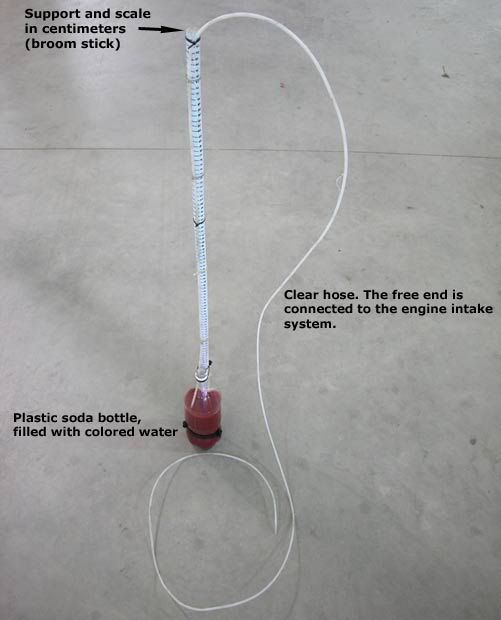 Because we expected to find very small pressure drop differences, we built this instrument , which is very similar to a barometer as you can see, that allows us to measure smaller pressure drops than any vacuum gauge we could find commercially in our country. Here the scale goes from 0 to 100 centimeters of water. As a reference, you may note that 1 cmH 2 O= 0.0142 PSI
Because we expected to find very small pressure drop differences, we built this instrument , which is very similar to a barometer as you can see, that allows us to measure smaller pressure drops than any vacuum gauge we could find commercially in our country. Here the scale goes from 0 to 100 centimeters of water. As a reference, you may note that 1 cmH 2 O= 0.0142 PSI
 As usual, we enlisted the help of our masked friend to take note of our sophisticated instrument readings while the vehicle was moving.
As usual, we enlisted the help of our masked friend to take note of our sophisticated instrument readings while the vehicle was moving.
 Performing the tests, on a highway in the city of Caracas.
Performing the tests, on a highway in the city of Caracas.
 These photos show the pressure drop readings taken while our test Land Cruiser was driven at 90 miles per hour and 5,500 rpm under full load. The reading on the left was taken with the snorkel intake facing forward, while the one on the right shows the pressure drop while facing backwards.
These photos show the pressure drop readings taken while our test Land Cruiser was driven at 90 miles per hour and 5,500 rpm under full load. The reading on the left was taken with the snorkel intake facing forward, while the one on the right shows the pressure drop while facing backwards.
RESULTS AND CONCLUSIONS
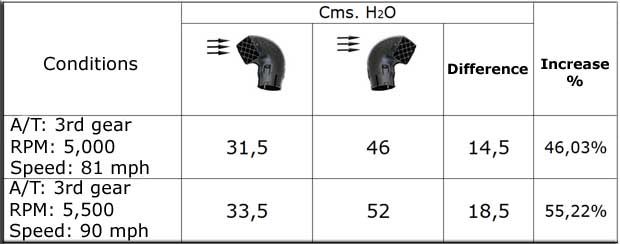 This table summarizes our test results. Each condition was tested three times, in order to minimize errors and to guarantee the repeatability this type of test requires.
This table summarizes our test results. Each condition was tested three times, in order to minimize errors and to guarantee the repeatability this type of test requires.
The results show that the intake system pressure drop increased a little over 55% when the vehicle was driven at 90 mph and 5,500 rpm if the snorkel intake was installed backwards.
In conclusion, just like we can wear a baseball backwards under exceptional circumstances, we can do the same by installing our snorkel intakes backwards in special conditions, such as when driving in jungle areas, where we wish to avoid tangling with branches or hanging vines.
Under other circumstances, particularly if we are driving at high speed, we believe that we have clearly demonstrated that installing the snorkel intake backward will have a detrimental effect on the engine's efficiency, Which Will Manifest Itself as power loss and an Increase in fuel consumption.
